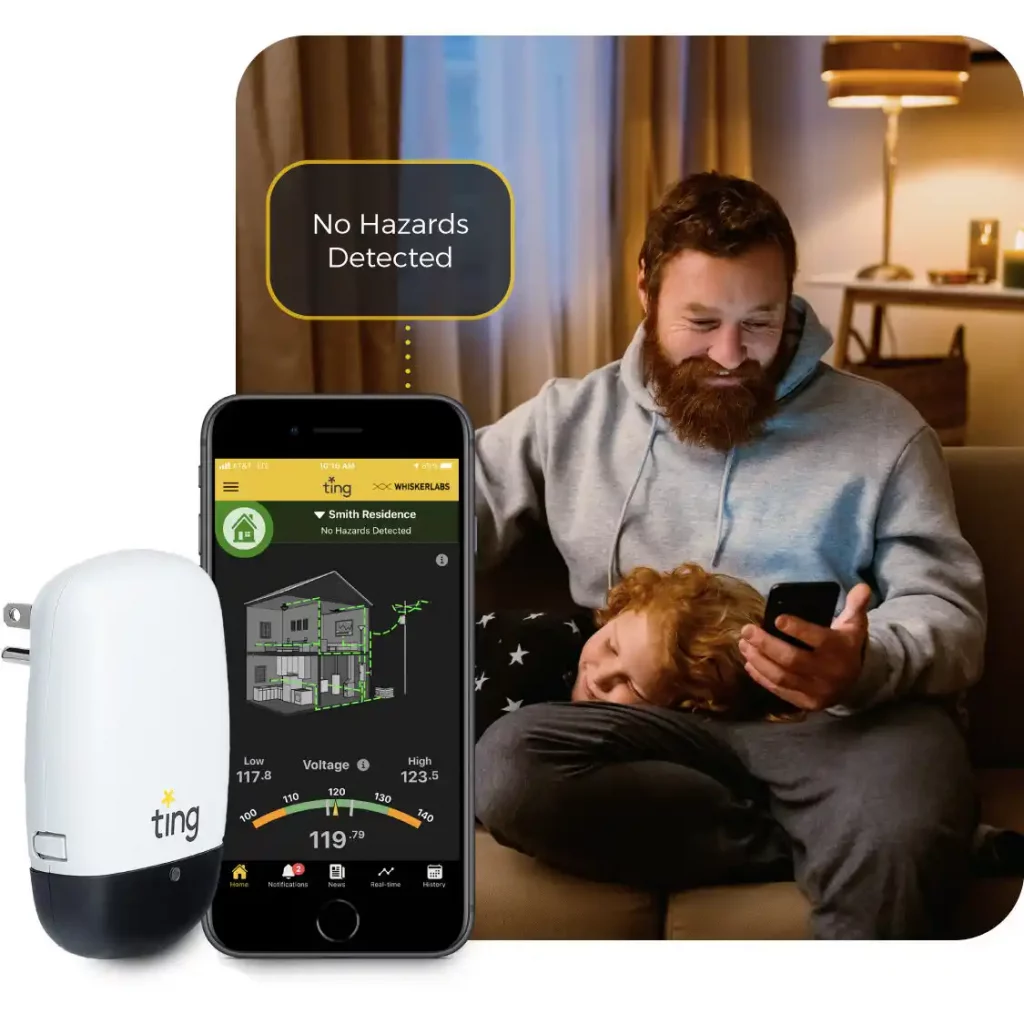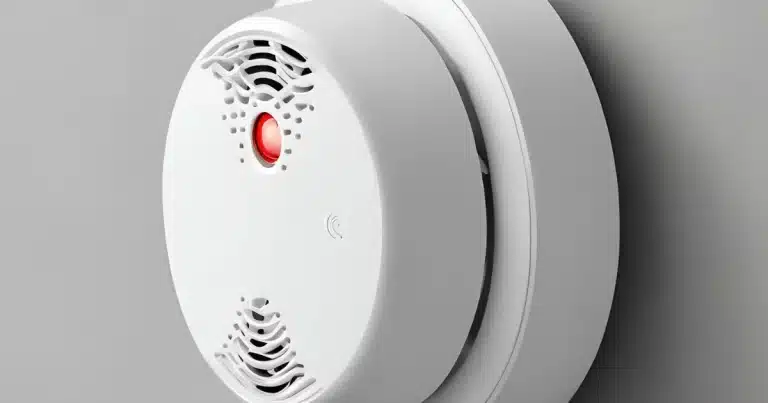When we think of home automation, we often imagine lights turning on by themselves or adjusting the thermostat remotely. But one area that’s often overlooked in smart homes is fire safety. In recent years, innovations like Ting Fire sensors have emerged, making it possible for homeowners to not only prevent fires but also react faster when things go wrong. Today, let’s talk about how the Ting Fire sensor integrates with home automation systems, how to install it, and why it’s one of the most important investments you can make for your home.
Ting Fire:
Imagine this scenario: You’re sitting at work, or perhaps relaxing on vacation, when suddenly, your smartphone buzzes with an alert: “Fire Detected in Your Home.” Instead of feeling panic, you feel reassured. With Ting Fire, you have real-time updates, automatic responses, and full control over your home’s safety—no matter where you are.
Let’s break down how Ting Fire’s smart sensors works, how they immediately take action, and how they can potentially call for help. It’s more than just an alarm—it’s a comprehensive fire detection and response system that can make all the difference in preventing a disaster.

How Ting Fire Sensors Detect Smoke and Fire
At the heart of Ting Fire’s system is its advanced sensor technology. These sensors don’t just rely on traditional methods like detecting smoke particles. Instead, Ting Fire employs multi-sensory technology, which includes:
- Smoke Detection: Ting Fire sensors use laser-based smoke detection to identify the presence of smoke in the air. This technology can differentiate between harmless smoke (like the kind that comes from burnt toast) and dangerous smoke from an actual fire. This means you won’t be getting false alarms every time you burn your breakfast!
- Heat Sensors: Ting Fire doesn’t just rely on smoke; it also incorporates heat sensors to monitor temperature changes in the home. A rapid increase in temperature is a strong indicator of a fire. By combining smoke and heat detection, Ting Fire can identify a potential fire even before it produces heavy smoke, giving you more time to respond.
- Carbon Monoxide Detection: Some advanced Ting Fire sensors also include CO detection, which is important because carbon monoxide is a dangerous byproduct of incomplete combustion and can be deadly in high concentrations. These sensors detect when carbon monoxide levels rise to dangerous levels, which can be a sign of a smoldering fire, providing additional early warnings.
- Air Quality Monitoring: Ting Fire sensors also monitor air quality. This allows them to detect potential fire-related issues like fumes, gases, or unusual air patterns that may indicate a hidden fire hazard.
These technologies work together to provide a comprehensive fire monitoring system that can detect the earliest signs of fire or smoke with high accuracy.
How Ting Fire Takes Immediate Action
When a Ting Fire sensor detects smoke, heat, or carbon monoxide, it doesn’t just sit idle—it activates a series of smart responses. This ability to take immediate, automated action is a game-changer in home fire protection.
Here’s how Ting Fire steps in:
1. Instant Notifications to Your Smartphone
Once the sensor detects something unusual, it sends an instant notification to your phone. This could be a simple alert saying “Smoke Detected in Kitchen” or a more urgent message like “Fire Detected in Living Room”. You don’t have to wait for the alarm to ring and wonder if the smoke is real. With real-time alerts, you are instantly aware of the situation, even if you’re at work, on vacation, or anywhere else.
2. Integration with Smart Home Devices
Because Ting Fire is designed to work within a smart home ecosystem, it automatically integrates with other IoT devices in your home to contain the issue and protect your home. For instance:
- HVAC Shutoff: If smoke is detected, Ting Fire can automatically shut down your HVAC system to stop the spread of smoke through the ducts. This action helps contain the fire in the affected area, preventing it from traveling to other parts of the home.
- Smart Lights and Alarm Systems: Ting Fire can also work with your smart lights to flash or turn on to provide a visual signal of an emergency. In some setups, the lights might flash in a specific pattern to indicate a fire, making it easier for people in the home to recognize the emergency. The system can also trigger a loud alarm to alert everyone inside your home, even if the sensor itself hasn’t been heard over normal household noise.
- Automatic Door Unlocking: Some advanced setups might include smart locks. In the event of a fire, Ting Fire can trigger these locks to unlock automatically, providing easier access for emergency responders or allowing you to safely exit the home.
3. Active Evacuation Features
One of the key advantages of Ting Fire is its ability to assist with evacuation. In case of a fire, the system can trigger pre-configured evacuation routines:
- Unlocking Doors Automatically: If there’s a fire, Ting Fire can send a signal to your smart locks to unlock doors. This ensures that you’re not left fumbling for keys during an emergency, and can quickly exit the building. For those with disabilities or other mobility challenges, this feature can be a life-saver.
- Routing to Safe Areas: Some advanced systems might also work with smart lighting to guide you toward safe exit routes. Lights will flash in the direction of the nearest exit, helping you navigate safely out of the home even if visibility is compromised.
How Ting Fire Can Call for the Fire Brigade
This is one of the most revolutionary features of Ting Fire. Automation doesn’t just stop at alerting you—it can notify emergency responders and take immediate action, increasing the chances of swift intervention before things escalate.
Integration with Emergency Services
When a fire is detected, Ting Fire can be linked to an alarm system that communicates directly with emergency services, such as your local fire brigade. If your system is connected to a third-party monitoring service, they can receive an instant alert and pass the information on to emergency responders.
How It Works:
- Step 1: The Ting Fire sensor detects smoke, heat, or carbon monoxide.
- Step 2: The sensor sends a notification to your phone, as well as to your smart home hub and connected systems.
- Step 3: Your system triggers alarms and evacuates the home (by unlocking doors or flashing lights).
- Step 4: Simultaneously, the system sends a signal to emergency monitoring services, which instantly contact the fire department with detailed information about your location, the extent of the fire, and the necessary resources needed.
In some cases, this information may include the exact location of the fire within your home (thanks to smart mapping) and whether anyone is trapped inside. This allows firefighters to be better prepared when they arrive, significantly improving the speed of their response.
Direct Call to Fire Services via Integrated Apps
Certain home automation systems offer direct integration with mobile applications or voice assistants like Alexa or Google Assistant. With Ting Fire, this could mean you could call for help with a simple voice command like, “Alexa, call the fire department”. This would automatically dial the emergency number and send your address.
The Proactive Fire Protection System
The most impressive part of Ting Fire isn’t just that it detects fire—it’s that it actively works to prevent fire disasters by integrating with your entire home automation system. The more connected the system is, the better it performs.
- Smart Feedback: After each detection event, Ting Fire provides detailed feedback on its sensors, alert history, and actions. You’ll know exactly what triggered the alarm, and if the response was enough, or if further action (like fire brigade intervention) is required.
- Data Logging: Over time, Ting Fire also logs and analyzes patterns in your home, allowing you to understand your fire risks better. For instance, it can analyze the frequency of temperature spikes or smoke levels, suggesting safer behaviors or even upgrading your sensors as your home’s needs change.
With Ting Fire, you’re not just installing a smoke alarm. You’re investing in a smart, proactive fire detection and prevention system that integrates seamlessly with your home automation setup. From real-time alerts and smart device interactions to automatic emergency responses and direct fire brigade contact, Ting Fire is designed to provide unmatched protection against one of the most dangerous threats to your home and family: fire.
How Much Does Home Automation Ting Fire Cost?
Now, let’s talk about the price. When it comes to smart home safety, many people are understandably cautious about the initial investment. Ting Fire sensors are priced based on features, models, and the number of sensors you need.
Here’s a general breakdown of the costs you can expect:
- Ting Fire Sensor (Single Unit): Typically, each Ting Fire sensor can cost anywhere from $100 to $150 depending on where you buy it, as well as any ongoing sales or promotions. Keep in mind, this price is for a single sensor, and you’ll likely need multiple units for larger homes or multiple rooms.
- Ting Fire Smart Hub: If you need a smart hub to connect all your devices and sensors together, expect to pay an additional $50 to $100.
Prices vary based on the model you choose, and it’s always a good idea to check popular retailers or the official Ting Fire website for the most current deals. Additionally, some retailers offer bundles that include multiple sensors or other smart home products, which can save you money in the long run.
Is the Cost Worth It?
Absolutely. While the upfront cost of Ting Fire may be higher than traditional smoke alarms, you’re paying for cutting-edge technology that offers real-time alerts, smart device integration, and peace of mind. In the event of a fire, Ting Fire can potentially save you from more expensive repairs, property damage, and even worse—loss of life. For me, that’s more than worth the investment.
How to Install Ting Fire in Your Home
Now that you’re convinced about the importance of Ting Fire in your home, let’s talk about how you can easily install this smart fire protection system.
What You’ll Need:
- Ting Fire Sensors (Choose based on the size of your home and the number of rooms you want to monitor)
- Smartphone (To install and configure the system using the app)
- Home Automation Hub (Optional but recommended for complete integration with other smart devices)
- Wi-Fi Connection (To link the system to your network and allow remote monitoring)
Step-by-Step Guide:
Step 1: Install the Ting Fire App
The first step is to download the Ting Fire app from the app store (it’s available on both iOS and Android). The app acts as the central hub for controlling the system and will walk you through the installation process.
Step 2: Mounting the Sensors
The next step is physically installing the Ting Fire sensors around your home. You’ll want to place them in key areas such as the kitchen, hallways, or near bedrooms. Make sure the sensors are placed in smoke-prone areas but away from direct sources like your stove or oven.
Mounting them is easy—just use the provided screws or adhesive pads to attach the sensors to the walls or ceiling. Once they’re securely in place, you’re ready to move on.
Step 3: Connect the Sensors to Wi-Fi
Open the Ting Fire app and follow the on-screen instructions to connect your new sensors to your home Wi-Fi. This will enable you to monitor and control the system remotely.
Step 4: Integrate with Other Smart Devices (Optional)
If you want your Ting Fire system to work alongside other smart devices like Alexa, Google Home, or a smart thermostat, follow the integration steps provided by the app. The system works seamlessly with popular smart home ecosystems, allowing you to set triggers and automations for enhanced safety.
Step 5: Test the System
Before you call it a day, make sure to test your Ting Fire system. Trigger a fake alarm (maybe by cooking something a little too crispy) and ensure that you receive the alert on your phone. Check that the smoke detection is functioning and that all of your connected devices (like thermostats or lights) react properly.
FAQ: Everything You Need to Know About Home Automation Ting Fire
1. How Does Home Automation Ting Fire Work Differently from Regular Smoke Detectors?
Regular smoke detectors simply emit an alarm when they detect smoke. But Ting Fire doesn’t just sound an alarm. It actively integrates with your home’s other systems, alerts you on your phone, and can even activate other safety measures like turning off the HVAC system to stop smoke from spreading. It’s not just reactive—it’s proactive.
2. Can I Control Ting Fire Remotely?
Yes! Ting Fire is designed for remote control via its app. From adjusting settings to receiving alerts, you can control the system from anywhere in the world as long as you have an internet connection.
3. How Do I Know If the Ting Fire System Is Compatible with My Existing Home Automation Devices?
Ting Fire works with popular smart home ecosystems like Amazon Alexa, Google Home, and Apple HomeKit. If you already use these systems, integrating Ting Fire should be a breeze. The app provides easy-to-follow instructions for syncing with your existing smart devices.
4. Is Installation Complicated?
Not at all! Installing Ting Fire sensors is straightforward and doesn’t require any special tools or expertise. Simply mount the sensors, connect them to your Wi-Fi network, and integrate them with your other devices. The app guides you every step of the way, so it’s a simple process for anyone to follow.
5. How Long Do Ting Fire Sensors Last?
Ting Fire sensors are built to last for several years, depending on use and maintenance. You should check the batteries regularly and perform routine tests to ensure everything is working properly. Some sensors even notify you when it’s time for maintenance.
Is Home Automation Ting Fire Right for You?
As our homes get smarter, it’s time to rethink traditional approaches to safety—especially when it comes to fire prevention. Ting Fire is more than just a smoke detector. It’s a fully integrated, intelligent system designed to detect fire hazards early and provide peace of mind no matter where you are. With real-time alerts, seamless smart device integration, and ease of installation, Ting Fire is an essential addition to any modern home automation setup.
If you value safety, convenience, and peace of mind, Ting Fire is a must-have in your home automation arsenal.
Ready to take your home safety to the next level? Discover how IoT and smart home automation can protect your family—click here to explore more!


This Post Has 6 Comments
Pingback: viagra 75
Howdy! Do you use Twitter? I’d like to follow you if that would be okay. I’m absolutely enjoying your blog and look forward to new updates.
I genuinely enjoy looking through on this site, it holds wonderful posts.
888slot là nhà cái cá cược trực tuyến uy tín hàng đầu châu Á, được cấp phép hoạt động bởi tổ chức First Cagayan Leisure & Resort Corporation (First Cagayan) uy tín tại Philippines. Với hơn 10 năm kinh nghiệm hoạt động, trang web đã và đang thu hút đông đảo người chơi tham gia.
888slot là nhà cái cá cược trực tuyến uy tín hàng đầu châu Á, được cấp phép hoạt động bởi tổ chức First Cagayan Leisure & Resort Corporation (First Cagayan) uy tín tại Philippines. Với hơn 10 năm kinh nghiệm hoạt động, trang web đã và đang thu hút đông đảo người chơi tham gia.
888slot là nhà cái cá cược trực tuyến uy tín hàng đầu châu Á, được cấp phép hoạt động bởi tổ chức First Cagayan Leisure & Resort Corporation (First Cagayan) uy tín tại Philippines. Với hơn 10 năm kinh nghiệm hoạt động, trang web đã và đang thu hút đông đảo người chơi tham gia.